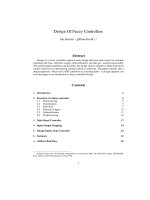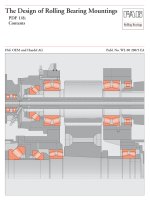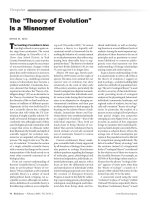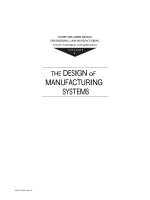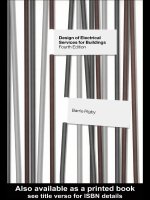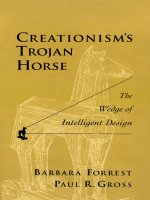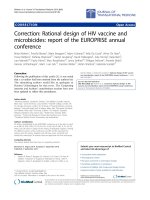Intelligent Design of Reconfigurable Machines Majid Tolouei-Rad doc
Bạn đang xem bản rút gọn của tài liệu. Xem và tải ngay bản đầy đủ của tài liệu tại đây (471.41 KB, 5 trang )
Abstract—This paper presents methodologies for developing an
intelligent CAD system assisting in analysis and design of
reconfigurable special machines. It describes a procedure for
determining feasibility of utilizing these machines for a given part
and presents a model for developing an intelligent CAD system. The
system analyzes geometrical and topological information of the given
part to determine possibility of the part being produced by
reconfigurable special machines from a technical point of view. Also
feasibility of the process from a economical point of view is
analyzed. Then the system determines proper positioning of the part
considering details of machining features and operations needed.
This involves determination of operation types, cutting tools and the
number of working stations needed. Upon completion of this stage
the overall layout of the machine and machining equipment required
are determined.
Keywords—
CAD, Knowledge based system, Reconfigurable
I. I
NTRODUCTION
TILIZATION
of special purpose machine tools is the most
economical way of producing very large quantities of similar
parts. However, these machines are criticized for the lack of
flexibility needed to respond today’s competitive and rapidly
changing market demands. In addition, despite incorporating high
capital costs these machines become useless when the part in
production is no longer needed. Consequently manufacturers often
prefer utilization of conventional or CNC machines even for large
production volumes. As a result, productivity is sacrificed for
flexibility and a higher cost per part is achieved. Reconfigurable
machines, a new generation of special purpose machines, can be
considered as a valid solution to tackle this crucial problem. These
are highly productive and relatively flexible providing an ideal
option for large production volumes where limited flexibility is
needed. Figure 1 shows a typical reconfigurable machine that
performs drilling and tapping operations on a number of similar
parts.
Reconfigurable machines make it possible to apply minor changes
to the structure of the machine by repositioning machining units and
accessories. This is extremely useful when there is a need for
production change due to rapidly changing market demands. Even
more, it is possible to totally disassemble the machine and re-
assemble it in a completely new configuration to produce a different
part. This becomes possible as the main components of the machine
are mounted on the chassis by means of mechanical fasteners such as
bolts and nuts. This provides these machines with great flexibility not
seen in other types of machine tools. R
reconfigurable machines
equipped with advanced technologies have shown
their
M. Tolouei-Rad is with School of Engineering, Edith Cowan University,
Joondalup, WA 6027 Australia. (e-mail: ).
Fig. 1 A reconfigurable machine with parts produced [1].
remarkable efficiency in automation of production lines and
machining processes with high qualities and quantities [2].
However, this technology has received little attention by
contemporary researchers despite the huge profit it can make.
Contributions on design and application of these machines are
limited to those published by the author [3-4]. The shortage of
skilled machine designers is also accountable for limited
utilization of these machines that is not justifiable with the
important role these can play in improving productivity.
Intelligent CAD systems have been extensively used to effectively
tackle some real engineering problems in the three decades. Yet
researchers explore new application areas for utilization of various
artificial intelligence techniques. Knowledge-based expert systems
(KBESs) proved to be effective for decision making when dealing
qualitative information hard to capture in a computer program.
Examples of application areas include design [4], process planning
[5-6], design analysis [7], and NC programming [8]. Accordingly,
this paper addresses a new application area for well-known KBESs:
design of reconfigurable machines.
II. GENERAL STRUCTURE OF RECONFIGURABLE
MACHINES
Heavy weight, rigid body, and inflexibility are of typical
specifications of traditional special purpose machines. In contrast,
reconfigurable machines are generally lighter and relatively flexible.
The general structure of reconfigurable machines consist a number of
machining and sliding units, and a part handling mechanism
assembled together on a chassis. This is shown in Figure 1.
A. Chassis and Table
Chassis and table are very important components in these
machines. On the basis of technical considerations of the machining
operations required to make the given part and also machining
properties of the part material, the table and chassis are properly
designed or selected from a collection of standardized tables and
chassis available. Due to high machining forces resulting from
Intelligent Design of Reconfigurable Machines
Majid Tolouei-Rad
U
World Academy of Science, Engineering and Technology 59 2009
278
machining operations the machine table and chassis should be
sufficiently rigid to avoid vibration. All other components of the
machine including machining and sliding units, and the part handling
mechanism are mounted on the chassis and table by means of
mechanical fasteners and special adjusting devices. Consequently, a
reconfigurable machine could be conveniently assembled to form a
modern special machine in minimal time for the specific production
need.
B. Machining and Sliding Units
The units used in the reconfigurable machines are divided
into two main categories: machining and sliding. Machining
units equipped with an electro-motor revolve the spindle by
means of pulley and belt systems in order to provide the
rotational movement of the cutting tool. Like other machine
tools, the connection of cutting tools to machining units is
done by standard tool holders. Machining units are of three
types: telescopic, power, and CNC. Telescopic units are used
for light drilling and taping operations as they also provide the
spindle with a telescopic linear movement necessary for
cutting tool penetration into the part. Both the linear and
rotational movements necessary for performing drilling and
tapping operations are provided simultaneously. Power units
are used for milling and drilling operations where high cutting
forces exist. Unlike telescopic units, power units lack the
linear telescopic tool movement due to the existence of high
cutting forces that may causing in telescopic movements.
Consequently, these units are carried on sliding units
providing them with necessary linear movements to penetrate
into the part material. Figure 2 illustrates a telescopic and
power-machining unit together with proper tool holders and
cutting tools.
Fig. 2 Power unit (top) and telescopic unit (bottom) [1].
As shown in Figure 3, CNC machining units equipped with
high quality servo-motors are also available for performing
drilling, taping and milling operations precisely. CNC units
can be programmed for very accurate machining operations
when used in conjunction with a controller.
Fig. 3 A CNC machining unit with its controller [1].
Sliding units carry machining units and provide necessary
feed movements for the cutting tool by means of hydraulic or
pneumatic cylinders or servomotors. Adjustment of movement
course is provided by micro-switches or mechanical systems.
Figure 4 shows a pneumatic sliding unit with a mechanical
course adjustment. The sliding plate that carries the machining
unit is fastened to the connecting rod of the piston, and
therefore, is capable of moving the cutting tool forward and
backward.
Fig. 4 Pneumatic sliding unit with course adjustment.
Fig. 5 CNC sliding units carrying machining units [1].
Depending on the nature of machining operation and
cutting tool movement requirements, the machining unit can
World Academy of Science, Engineering and Technology 59 2009
279
be mounted on the sliding unit such the spindle axis is either
along or perpendicular to the sliding direction. This is shown
in Figure 5. As shown in the Figure, the sliding units can also
be equipped with servomotors to make programmable CNC
sliding units available for accurate movements.
III.
SYSTEM ARCHTECTURE
The design of reconfigurable machines is a time-consuming
process requiring expertise and an in-depth understanding of
these machines and accessories. The use of KBES is
considered as a proper solution to improve the efficiency of
the design process of these machines. This is mainly due to
the capability of these systems in (1) restoring qualitative
knowledge, and, (2) integrating with databases containing
quantitative information. Figure 6 shows general architecture
of the system and its main components. It consists a user
interface, KBES, CAD unit, feature recognizer, and the
interface unit integrating all these components in a system.
Fig. 6 General architecture of the system and its components.
A. Economic and Technical Analyses
The cost of utilizing reconfigurable machines is relatively
high. Therefore, critical economic and technical justification
of applying these machines should be made before any
attempt is made to design and manufacture one. This includes
a critical economical analysis of the part in question and its
production characteristics; followed by a careful analysis of
technical issues taking into consideration the types of
machining operations required, the characteristics of the
workpiece material, and the geometry of machining features.
Both tasks are time-consuming and require a high level of
expertise and experience, and unfortunately, there is a
shortage of skilled people. As previously stated KBES have
proven to be capable of processing both qualitative and
quantitative information efficiently. Consequently, this
approach has been considered as a potential solution to
efficiently tackle this problem.
The KBES shown in Figure 6 assists the user in economic
and technical evaluations of reconfigurable machines. It
consists a knowledge base, a data base, and an inference
engine. The knowledge specific to the domain of economical
and technical analyses of the part for utilization of
reconfigurable machines is represented in the form of IF-
TEHN rules. The system restores input and output information
of analysed parts in the data base for future use. Thus it adds
to its existing knowledge. The inference engine actively uses
the knowledge restored in the knowledge base to obtain the
required parameters. The input to the system could be in the
form of geometric and physical information of the part or in
the form of group technology codes.
To analyse a part the inference engine first searches the data
base to see whether the part in question has been processed in
the past. If the part is defined using group technology codes
then the system also searches for similar parts restored in the
data base. If the part has been previously processed then the
system uses the information restored in the data base. If a
similar part is found then the information of the similar part is
displayed. If the part is new part and has not been processed
before, or if the operator decides to re-process a previously
processed part then the inference engine fires appropriate rules
on a forward chaining basis to determine the feasibility of
utilizing a reconfigurable machine to produce it. In this case
the system provides a cost per part comparison of two
commonly used production methods (a) CNC machines or (2)
reconfigurable machines. For the economical analysis, factors
such as machining time, production volume, operators’ wages,
machine capital cost, amortisation cost, maintenance costs,
cutting tool costs and overhead costs are considered to decide
if reconfigurable machines provide a lower cost per part in
comparison with other alternatives. It is also possible to
include a cost computation when conventional machines are
employed, although not used for quantity productions. After
completion of economic analysis if should be decided whether
or not to go ahead with the reconfiguration machine approach.
If this approach is still of interest then a technical analysis
should be carried out to investigate the feasibility of this
method from a technical point of view. Factors such as
World Academy of Science, Engineering and Technology 59 2009
280
geometrical and topological information of the part, cutting
tools, cutting forces, and material properties are all taken into
consideration. In this paper it is not intended to provide
detailed economical and technical analyses and interested
reader is recommended to refer to another paper published by
the author [3].
B. Feature Recognition
Upon confirmation of the feasibility of the utilizing the
reconfigurable machines to produce the part from both
economical and technical points of view, all of the machining
features must be identified and appropriate cutting tools and
parameters determined. Properly selection of cutting tools and
machining parameters is of great importance in the success of
any machining operation. The flowchart shown in Figure 7
illustrates different feature recognition steps. Currently this is
limited only to the hole features. A 3D solid model of the part
created by user or imported from another CAD system is
made available to the system. A feature recognizer restored as
a supplementary program interactively identifies existing
holes on the part and determines the parent plane (or face) for
each hole. Parent feature are considered as the faces to be
machined to generate holes. The parent feature with most
holes is chosen as current plane and the required drilling tip
and parameters for machining each hole on this plane are
assigned using the data restored in the data base. This process
is repeated for other parent planes until all processed. For each
feature identified proper cutting tools and machining
parameters are automatically determined by firing appropriate
rules in the knowledge base and also by use of the information
of available cutting tools restored in the data base.
C. Selection of Machining and Sliding Units
Machining and sliding units are the most important
components of reconfigurable machines that provide the
cutting tool with rotational and linear movements necessary
for cutting. Consequently, the selection of machining units,
sliding units and accessories are performed such that the
following two conditions are met. 1) Determined cutting tools
are capable of making rotational and linear movements
necessary for performing corresponding machining
operations. 2) Appropriate machining parameters such as
spindle speeds, feedrates, depth of cuts are provided for all the
cutting tools. The selection of machining and sliding units is
performed by the KBES using the information restored in the
data base. This is only done after determination of cutting
tools and machining parameters since the geometry of cutting
tools and machining parameters dictate required powers,
velocities, and required movements.
D. Machining Sequence Planning
Properly determination of machining operations and putting
this operation in the right sequence is vital to successful
design and manufacture of reconfigurable machines A poor
machining sequence plan leads to lower quality of production
and/ or increased machining times and consequently
higher
Fig. 7 Flow chart for feature recognition and determining cutting
tools and parameters.
production costs. Often it is possible to combine and perform
a number of operations in a single setup lowering machining
times and costs. Indeed machining sequence planning
determines the overall configuration of the machine and
required machining units and accessories.
E. Machine Layout
Determination of machine layout can be considered as the
most important step in the design process of reconfigurable
machines. Failure to properly accomplishing this step leads to
anything other than economic production. A poor layout
determination may result in a machine design not responding
to production needs and increased machining times and costs.
Generally two methods of single-station and multi-station
layouts are used in design of reconfigurable machines. In the
World Academy of Science, Engineering and Technology 59 2009
281
first method, the part is in a fixed position on the machine
table and is machined in a single machining setup. In the
second method the part is repositioned from one station to the
next until processed in all stations. The method chosen for a
given part depends on specifications of the part and
production. Generally a multi-station machine results in a
higher production rate because of simultaneous machining of
several parts in different stations.
To properly determine a layout for the reconfigurable
machine the user consults with the KBES through the user
interface module. The user enters the information of the part
in the form of group technology codes and inputs required
information such as part set-up and clamping method, part
repositioning method preference if needed. In case of multiple
working stations the part needs to be transferred from one
working station by a linear motion provided by a sliding unit,
or a rotational motion provided by an indexing table. Often
when there are more than two working stations, a rotational
movement using is preferred.
Upon processing this information the system retrieves an
appropriate layout design from the data base. The layouts
presented explicitly shows the number of working stations.
The user may accept the presented layout design or request for
another design to be provided. It is also possible for the user
to modify the layout provided. In this case the result is
assigned a new code and restored in the database for future
use. On the basis of this layout the system assists designer in
determining part set-up and clamping method, position and
orientation of machining and sliding units, indexing table and
all other accessories.
IV. CONCLUSIONS
Application of reconfigurable machines significantly improves
machining productivity in comparison with other production
alternatives. Reconfigurability of these machines make them quite
useful in responding to rapidly changing market demands, feature not
seen in traditional special machine tools. These machines can be
altered or disassembled and then reassembled in a different
configuration to produce a different part. However, due to shortage
of skilled designers these machines are not used very often. The
system described here greatly assists designers in properly
economical and technical analyses of the utilization of these
machines and in determining required cutting tools and parameters,
and finally determining appropriate machine layout for producing the
part needed. This is of great importance as it lowers the level of
expertise needed and significantly reduces the machine design time.
The system described here is limited to drilling operations and more
work is needed to cover other machining operations. However, a
similar approach could be used to cover other operations.
REFERENCES
[1] Suhner Corporation General catalogue, “Automation Expert,”
Switzerland, 2001.
[2] M.P. Groover, “Automation, Production Systems, and Computer
Integrated Manufacturing,” Prentice Hall, NJ, USA, 2008.
[3] M. Tolouei-Rad, and S. Zolfaghari, “Productivity improvement using
Special-Purpose Modular machine tools,” Int. J. Manufacturing
Research, Vol. 4, No. 2, pp. 219–235, 2009.
[4] M. Tolouei-Rad and S. M. Tabatabaei, “Design and manufacture of
modular special purpose machine tools,”Design and manufacture of
modular special purpose machine tools, Int. Conf. on Achievements in
Mechanics, Manufacturing and Materials Science, 6-9 Dec., Giliwice-
Zakopane, Poland, 2005.
[5] S. Myung and S. Han, “Knowledge-based parametric design of
mechanical products based on configuration design method,” Expert
Systems with Applications, Vol. 21, Issue 2, pp. 99-107, 2001.
[6] S. C. Park, “Knowledge capturing methodology in process planning,”
Computer-Aided Design, Vol. 35, Issue 12, October 2003, pp. 1109-
1117, 2003.
[7] L Patil and S. S, Pande, “An intelligent feature process planning system
for prismatic parts,” International Journal of Production Research, Vol.
40, No. 17, pp. 4431-4447, 2002.
[8] M. Novak, and B. Dolšaka, “Intelligent FEA-based design improvement,
Engineering Applications of Artificial Intelligence,” Vol. 21, Issue 8,
pp. 1239-1254, 2008.
[9] M. Tolouei-Rad and G. Payeganeh “A hybrid approach for automatic
generating of NC programs,” Journal of Achievements in Materials and
Manufacturing Engineering, Vol. 14, No. 1 & 2, pp. 83-89, 2006.
Majid Tolouei-Rad is a Senior Lecturer at School of Engineering, Edith
Cowan University in Perth, Australia. He received his PhD in Mechanical
Engineering from the University of South Australia in 1997. Since then he has
been extensively involved in tertiary teaching and research and supervising
research students. He has worked as a Consulting Engineer for Industries and
a Professor for Reputable Universities in Iran, Canada and Australia. His
research interests include computer-integrated manufacturing, robotics and
automation, materials and manufacturing.
World Academy of Science, Engineering and Technology 59 2009
282


